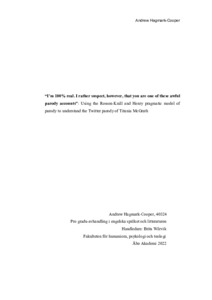“I’m 100% real. I rather suspect, however, that you are one of these awful parody accounts” : Using the Rossen-Knill and Henry pragmatic model of parody to understand the Twitter parody of Titania McGrath
Hagmark-Cooper, Andrew (2022)
Hagmark-Cooper, Andrew
2022
Julkaisu on tekijänoikeussäännösten alainen. Teosta voi lukea ja tulostaa henkilökohtaista käyttöä varten. Käyttö kaupallisiin tarkoituksiin on kielletty.
Julkaisun pysyvä osoite on
https://urn.fi/URN:NBN:fi-fe2022013011279
https://urn.fi/URN:NBN:fi-fe2022013011279
Tiivistelmä
Parody is a prevalent form on the social media platform Twitter. The academic literature has thus far focused on the parody of the so-called ‘irreverent internet’, which is playful in nature and frequently pays tribute to what it parodies. There is, however, another kind of parody on Twitter which has an altogether more hostile relationship to what it parodies. @TitaniaMcGrath is a prominent parody Twitter account of the latter type. This thesis has a primary and secondary aim: The former is to expand our understanding of the breadth of parody on Twitter by applying the pragmatic model of parody developed by Rossen-Knill and Henry (1996) to the tweets of @TitaniaMcGrath. The latter is to evaluate the Rossen-Knill and Henry pragmatic model as a tool for understanding parody. A random sample of 50 tweets taken from a two-year period between 1 January 2019 and 31 December 2020 is subjected to a close-reading analysis in relation to the four essential acts of the Rossen-Knill and Henry model.
The thesis finds that the tweets of @TitaniaMcGrath parody both particular expressions of opinion produced by a variety of organisations and individuals and a more abstract idea of a kind of person and set of beliefs that are commonly termed ‘woke’. In fitting with the medium of Twitter, the parody is mostly topical, and the opinions targeted are usually, though not always, extreme and provocative. Among the sampled tweets, a large majority proved to be concerned with one or more of four topics: race, transgenderism, toxic masculinity and free speech. In contrast to the parody of the irreverent internet, @TitaniaMcGrath’s criticism is harsh and accompanied by a humour that mocks and ridicules its object. In addition, this study finds that the Rossen-Knill and Henry pragmatic model provides a useful tool for analysis of Twitter parody. However, flaunting, whereby the desire to parody is intentionally signalled in the re-presentation of the object of parody, is found to be completely absent in at least one @TitaniaMcGrath tweet and non-essential for the purpose of parody recognition. The author tentatively suggests that flaunting is not integral to parody and could be detached from the Rossen-Knill and Henry pragmatic model of parody, leaving the model centered on the relationship between the parody, its object and the parodist’s humorous critique.
The thesis finds that the tweets of @TitaniaMcGrath parody both particular expressions of opinion produced by a variety of organisations and individuals and a more abstract idea of a kind of person and set of beliefs that are commonly termed ‘woke’. In fitting with the medium of Twitter, the parody is mostly topical, and the opinions targeted are usually, though not always, extreme and provocative. Among the sampled tweets, a large majority proved to be concerned with one or more of four topics: race, transgenderism, toxic masculinity and free speech. In contrast to the parody of the irreverent internet, @TitaniaMcGrath’s criticism is harsh and accompanied by a humour that mocks and ridicules its object. In addition, this study finds that the Rossen-Knill and Henry pragmatic model provides a useful tool for analysis of Twitter parody. However, flaunting, whereby the desire to parody is intentionally signalled in the re-presentation of the object of parody, is found to be completely absent in at least one @TitaniaMcGrath tweet and non-essential for the purpose of parody recognition. The author tentatively suggests that flaunting is not integral to parody and could be detached from the Rossen-Knill and Henry pragmatic model of parody, leaving the model centered on the relationship between the parody, its object and the parodist’s humorous critique.
Kokoelmat
- 6121 Kielitieteet [144]
